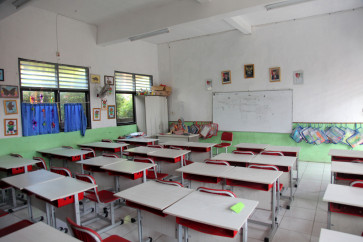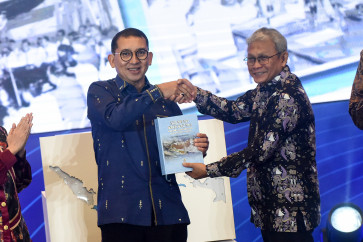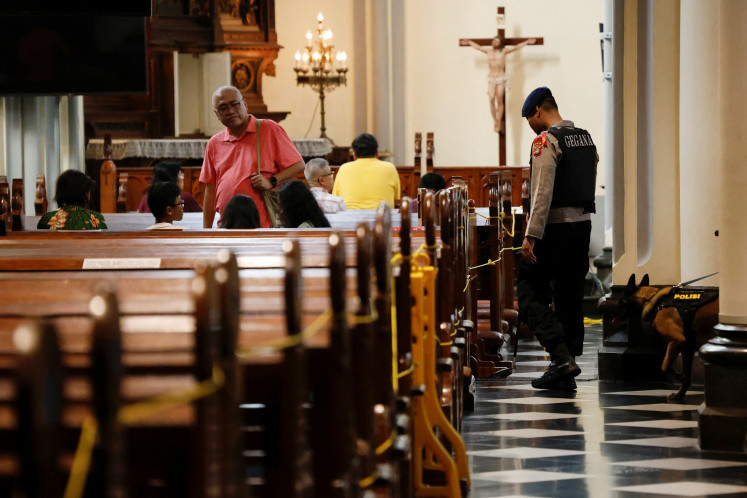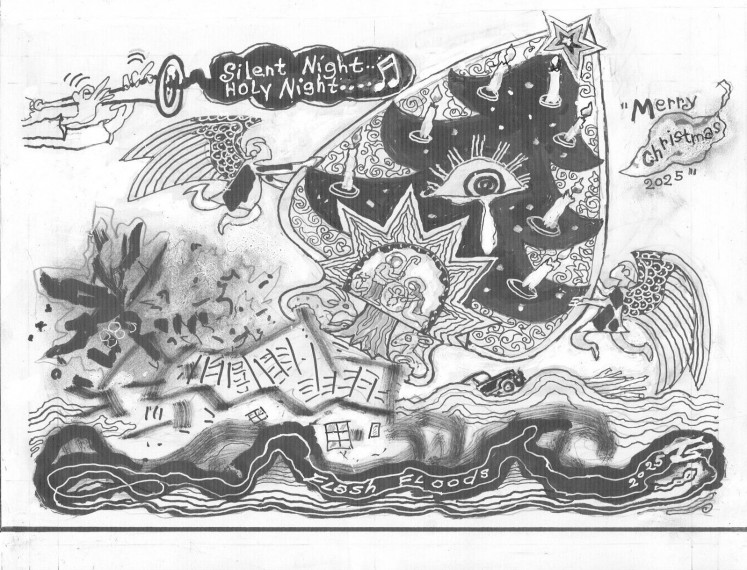Popular Reads
Top Results
Can't find what you're looking for?
View all search resultsPopular Reads
Top Results
Can't find what you're looking for?
View all search results'Opera Gandari': New perspective on Mahabharata character
Questions and answers: Indonesian senior artist Christine Hakim talks during a press conference on a new play, Opera Gandari, in Jakarta
Change text size
Gift Premium Articles
to Anyone
Q
uestions and answers: Indonesian senior artist Christine Hakim talks during a press conference on a new play, Opera Gandari, in Jakarta. (JP/Dionnasius Aditya)
Opera Gandari promises an all-embracing art form based on Goenawan Mohamad’s depiction of the Mahabharata character.
Sanskrit epic the Mahabharata is filled with a plethora of memorable characters. There are the main protagonists — the Pandawa — consisting of five siblings blessed with extraordinary abilities, themselves being incarnations of various deities within the Hindu religion. The five siblings include the wise Yudistira, the powerful Bima, the kind Arjuna, the handsome Nakula and the diligent Sadewa.
While the five protagonists are arguably the most recognizable characters in the epic, their nemeses are not easily forgotten. In the Mahabharata, the Pandawa go up against the Kurawa, which consist of 100 siblings led by Duryodana and Dursasana, the former’s own cousins. In the story, the two rival families fight each other until the Pandawa ultimately emerge victorious.
Then there are the secondary characters, including Gandari, the mother of the Kurawa. In the Mahabharata lore, she is most famous for being depicted with a blindfold, a result of her solidarity to her husband Dretarasta who was born blind. She is also known to be a virtuous character in the epic, in spite of her sons’ eternal rivalry against the Pandawa.
The character of Gandari, while not a major player in the epic, has been the subject of several adaptations. One of her most notable depictions was in the form of a poem by Indonesian poet and writer Goenawan Mohamad, titled Gandari. The poem itself has been adapted twice, in 2014 at Teater Jakarta and in 2015 in Frankfurt.
However, there is going to be a third adaptation of Mohamad’s poem, this time by Yayasan Rumah Musik Indonesia as part of their MUSIKINI program. The adaptation, titled Opera Gandari, will take place at Taman Ismail Marzuki in Jakarta on Dec. 14 and 15.
As the title of the play suggests, the adaptation of Mohamad’s poem will come in an operatic style alongside contemporary music, choreography and choir. According to director and choreographer Melati Suryodarmo, the opera will take a look into the character of Gandari, including her psyche and values during the story of the Mahabharata.
“Within the story, Gandari is characterized as a strong, resilient and loyal wife to her husband, so much so that she blindfolds herself in solidarity with him,” said Melati at a press conference on Thursday.
This depiction of the Mahabharata character is in part due to Melati’s own perspective of femininity in today’s society.
“We reflect on Gandari as a normal woman,” remarked Melati. "A woman with her own feelings, emotions and perspective on everything that’s happening around her.”
“All of these happenings were chronicled in great detail by Goenawan Mohamad.”
With this angle of womanly values and an emotionally driven story, Melati would like to take a different approach from the Mahabharata.
“‘The Mahabharata usually puts the spotlight on the personages and the characters. In our rendition of Gandari, we don’t do that,” explained Melati.
“We’ll focus on values instead, which will emerge through the unity of art style, choreography, narration and music.”
This incorporation of multiple art forms within a single work of art is commonly known as a gesamtkunstwerk, or a “total work of art”.
In Opera Gandari’s case, Melati promised that all artistic aspects of the play would work in harmony without one overshadowing the other.
“So, it won’t be the music accompanying the dancing or vice versa,” asserted Melati. “The music won’t be complete without the narration, the choir and the dancers.”
“It’s all in a single unity.”
To achieve this, Melati collaborated with musicians Tony Prabowo and Peter Veale, who acted as the opera’s composer and conductor, respectively. Joining them are Jay Subyakto as the artistic director, Christine Hakim as the narrator, Bernadeta Astri as a solo singer and Avip Priatna as the chorus master.
For Peter Veale, the production of the opera presented a challenge, partly due to the nature of the opera itself.
“The opera is really challenging,” said Peter. “It’s a modern opera, but one that is extremely expressive. It would be a challenging feat for musicians not used to playing some complicated rhythms.”
In spite of the demanding musical requirements, Peter was generally satisfied with how the opera came together, particularly with the musicians involved.
“I’ve been really impressed with the improvement, dedication and focus of the musicians,” praised Peter.
“The potential for this ensemble is enormous and I hope there will be many possibilities in the future.”
All in all, the opera’s presentation and delivery is hoped to be something different, something that will leave a lasting impression on its audience, according to Melati.
“We’re inviting the audience to think instead of taking everything at face value,” remarked Melati. “In performing arts, it truly is a special occasion when the audience is brought to the realm of their own perspectives and feelings.”
This enthusiasm was shared by Christine Hakim, the narrator for Opera Gandari.
“It’s important that we keep an open mind without creating frames beforehand,” advised Christine. “So instead of using frames, we understand art using feelings.”
“That’s where the power of feelings lies, to experience art.”
— The writer is an intern at The Jakarta Post.










